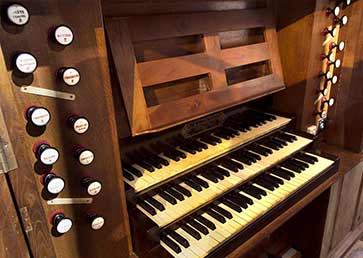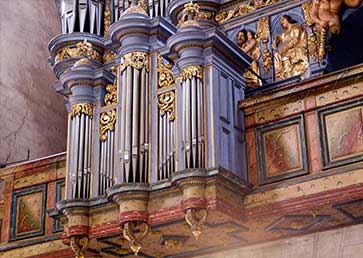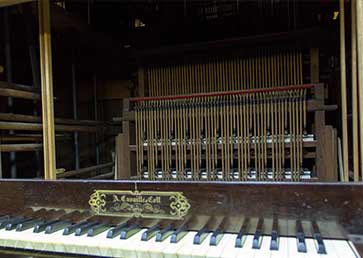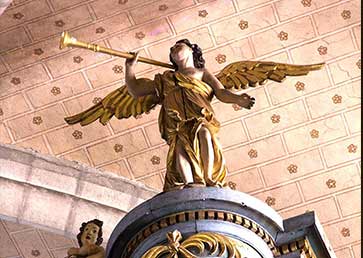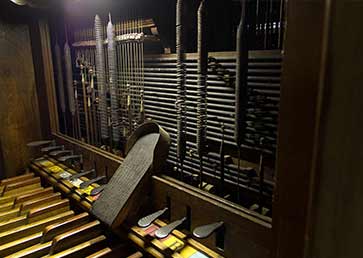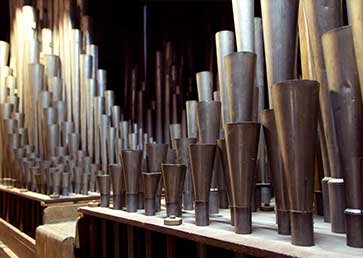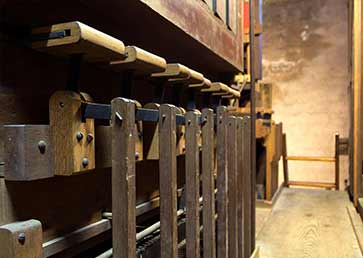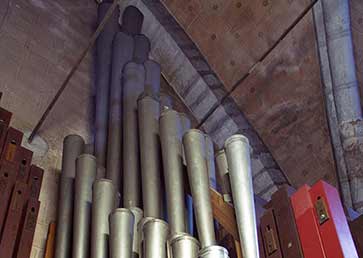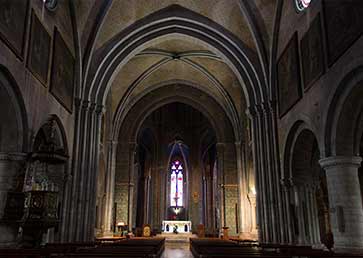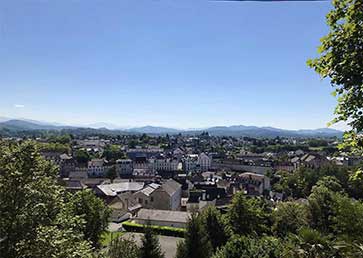The great organ of Sainte-Marie cathedral in Oloron-Sainte-Marie (France) was built in 1870 by the famous organ builder Aristide Cavaillé-Coll. The original organ dates back to the 17th century. It was most likely built by a member of the Clicquot dynasty. However, during the French revolution of 1789 the organ was emptied of its pipes. Undoubtedly, the pipes were melted down to make ammunition. In 1870, Aristide Cavaillé-Coll built a new organ in the existing place. At the same time, he painted it brown. In 1982 Danion-Gonzalez organbuilding company removed the brown paint to let appear magnificent blue original paint. He also cleaned the instrument.
Today the organ is in the same condition as in 1870 when Cavaillé-Coll finished building it.
The instruments has 3 manuals, from which two are speaking ones (have stops assigned to them) and one is a coupling one. The couplers are controlled by pedals above the pedal keyboard. This feature, supplied by a Barker machine, is relatively unique in Cavaillé-Coll history and gives more coupling possibilities, especially suboctave coupler for the first keyboard. There are 24 stops distributed into three divisions, which are structured in the French traditional organ construction.
- Récit expressif – It’s an 8 stops model that we find in may A.C.C pipe organs at that time. Reeds and Octavin 2 stops are activated by the foot pedal. It has a sweet and slow tremulant, and all stops are enclosed. Shades of the swell box are mounted on three sides of the case. It has a chromatic wind-chest. The swell box is situated behind the central part at the altitude of the Grand-Orgue section.
- Grand-Orgue – This 12 stop disposition is pretty standard for A.C.C organs, but their low-pitched Plein-Jeu Harmonique based on 16 feet is uncommon as well as 16, 8 and 4 feet reeds in a small-medium instrument like this. It is situated in the main case, split into C and C# sides. This section starts at an altitude of prospect pipes (the lower part of the organ case contains the Barker machine and bellows).
- Pédale – It consists of 4 stops. Bombarde 16 and Trompette 8 are pretty loud in reality. It is supposed that the leather part of the shallots was removed or just worn out over time, what resulted in louder sound, so the volume of these stops was slightly reduced in the sample set to recover the original sound balance. This section is split into C and C# sides on the opposite sites of the enclosure box.
It is worth noticing that the positive case is empty, dating back to the antique organ. It was too small for A.C.C pipes.
This organ is very eclectic. It is possible to play the 17th French classical pieces, or J.S. Bach works. It is also perfect for playing French romantic and symphonic composers, such as César Franck, Louis Vierne or Charles-Marie Widor.
In France, this organ has extraordinary fame, and it is a precious testimony of Aristide Cavaillé-Coll organ building.
Technical details
Order
Choose which version you want to order. If you want to try the demo first, use the Add to cart button close to Demo version label and proceed to the checkout to get the download link. The only limitation of demo versions is the number of available stops. Click Show demo version button under the stoplist to see the available stops.
GrandOrgue users, please read this page before ordering.
Updates
Last update: 8th August 2022
Downloads:
Full version 1.06 Demo version 1.06
Release notes:
1.01 - Fixed an issue related to combination system and stops with red label (anches), corrected two notes of Principal 16
1.02 - Improves performance
1.03 - Fixed background colour of Voix humaine 8' stop in Simple Jamb screen
1.04 - Fixed incorrectly displayed Accoupleur keyboard on some systems. Orage is now working from the Left Jamb view.
1.05 - Added detuning feature. Now key/stop action noises and blower/ambient noises are stored in presets, as well as the detuning level values.
1.06 - Small fixes.


